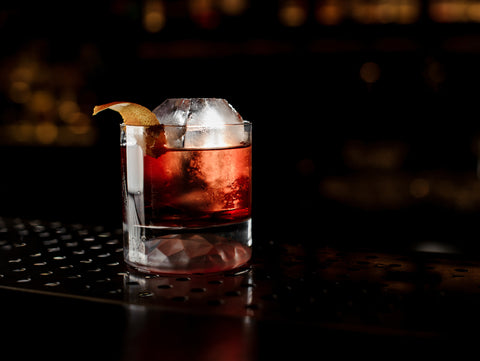True to their names, aperitifs classically precede a meal, and digestifs are the chasers that help it go down easy. Some bartenders would tell you that mixing that up - shooting a bitter Amaro with appetizers, or enjoying Campari with dessert - is backwards, a recipe for an upset stomach, or just deeply un-Italian. Others might offer cocktails from either family of beverages before, during, and after the meal, and leave it to you to decide what you’ll drink when.
Traditionalists have their reasons. The sweetness of aperitif wines was meant to stimulate the appetite when sitting down to eat, while the heavy botanical content of many digestifs may settle the stomach after dinner.
On the other hand, the right drink at any time is the one you like, and it’s no surprise that Americans are serving and enjoying these two deep and delicious classes of booze in all kinds of ways. Let’s find some good bottles and recipes to start with.
Choosing and mixing aperitifs

If you’re setting out to learn aperitifs, stock your bar with a few varieties of vermouth, at least one dry and one sweet; plus one bitter liqueur like Campari, Aperol, or Gran Classico. You should also keep some inexpensive red, white, or sparkling wine, any of which can serve as the base of an aperitif cocktail. Your preferred bag-in-box wine is just fine here.
Good vermouth is delicious and refreshing on its own. Try each of your purchases by itself, over ice with an olive or expressed orange peel garnish, and get familiar with their sugar level and flavor profile. Another good way to find your palate for dry vermouths is to try them in Martinis with a gin or vodka you already like, and see which vermouth suits you best. Likewise, you can test your sweet vermouths with whiskey by making simple Manhattans.
To see how your dry vermouth and bitter liqueur get along, you can try mixing the the Sunny Day Real Estate.
The Negroni - equal parts gin, Campari, and sweet vermouth - may now be the most popular aperitif cocktail in America. Its inspired endless riffs, and if you want to put your own spin on it, look to bright, fresh fruits. When you make it with an ounce of each ingredient, try dressing it up with a half ounce of Rio Red Grapefruit Syrup or Raspberry Gum Syrup. You can go easy on the sweet vermouth if you don’t want the syrups to make your Negroni too much sweeter.
If you’d like a more complex Negroni riff with both spicy ginger and pineapple, you can try the Roman Holiday.
Choosing and mixing digestifs

There’s a vast range of drinks that can be called digestifs. In Italy, it would include the dark, complex, and deeply bitter amari; the clear and mighty grappa; and sweet liqueurs like limoncello and sambuca. In Spain and Portugal, sweet Sherry and Madeira wines might be taken after dinner, the same way one might enjoy Portugal’s Port wine. In France, the great brandies of Calvados, Cognac, and Armagnac often reach the table after dinner, even though they’re neither sweet nor bitter nor dosed with botanicals.
If you’d like to start mixing cocktails with digestifs, you can start by stocking a classic dark amaro or two, one liqueur driven by a flavor you personally enjoy like Becherovka (cinnamon, ginger) or limoncello, and a brighter herbal liqueur like Strega or Chartreuse. If you don’t want to spend Chartreuse money just yet, inexpensive Alpine liqueurs like Boomsma Cloosterbitter and Génépy des Alpes are nice ways to dip your toes in that green, herby direction. If you like to keep it light after eating, look for one of those Sherries or Madeira wines, or for Barolo Chinato or Cardamaro: deep and satisfying wine-based preparations that offer botanical enrichment at vermouth proof.
 If you like the idea of a digestif without any sugar, look for grappa or for one of those French brandies. These can get expensive and for good reason. Your best bets for a good value might be a Calvados, an American brandy in the French style, or the Greek grappa equivalent tsipouro.
If you like the idea of a digestif without any sugar, look for grappa or for one of those French brandies. These can get expensive and for good reason. Your best bets for a good value might be a Calvados, an American brandy in the French style, or the Greek grappa equivalent tsipouro.
The world of amari is vast and diverse. To start, you could choose one that’s a balanced blend of botanicals, like Averna, Nonino, Montenegro, or Ramazotti; plus one that’s defined by a specific vegetable ingredient, like Cynar (artichoke) or Zucca (rhubarb). You could also pick up a Fernet, the bold style alternately loved and dreaded for its powerful, often mentholated flavors. If you're buying just one to start, choose a jack-of-all-trades like Ramazotti for cocktail flexibility.
The most popular digestif-driven cocktail in the world may be the Fernet and Coke. The lesson there is that amari play well with similary dark, rich, and bitter flavors - not only cola but coffee, caramel, and chcolate, which may guide your after-dinner bartending ideas.
That pairing advice can go for the other digestifs, too. If you've invested in a bottle of good brandy - and your bartending skills - consider offering your guests the elegant, chocolate-tinged Persian Sour after dinner.
The classic Champs-Élysées is a great way to mix French brandy and Chartreuse. If you bought cheaper alternatives, this is a good cocktail to riff with because its other ingredients are very simple.
Barrel-aged spirits like brandy, whiskey, and aged rum and tequila are good bets to mix with amari. Easy Speak is a great example that’s also perfect after dinner.
The Final Word
 If you’re just getting into the aperitif and digestif worlds, you’ll find they’re as rich in history and custom, and as intertwined with food as any other class of beverage. They can be intertwined themselves: look at how recipes like the Midnight Matinee and the Paper Plane combine the brightly and darkly bitter. As ever, let both history and your own palate be your guides.
If you’re just getting into the aperitif and digestif worlds, you’ll find they’re as rich in history and custom, and as intertwined with food as any other class of beverage. They can be intertwined themselves: look at how recipes like the Midnight Matinee and the Paper Plane combine the brightly and darkly bitter. As ever, let both history and your own palate be your guides.


